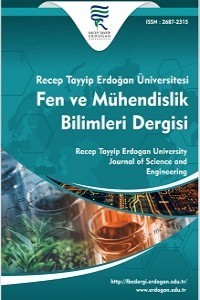Ovit Dağbaşı Gölü Suyunda Doğal Radyoaktivite Konsantrasyonlarının Belirlenmesi
Doğada yaşayan tüm canlılar sürekli olarak doğal ve yapay radyasyon kaynaklarından yayınlanan iyonlaştırıcı radyasyona maruz kalmaktadır. Bu nedenle, yaşam alanları ve ziyaret edilen bölgelerde radyoaktivite düzeylerinin belirlenmesi önemlidir. Bu çalışmada, Rize ili İkizdere ilçesine bağlı İkizdere-İspir karayolu üzerinde bulunan Ovit Dağbaşı Gölünden alınan su örneklerinde 226Ra, 232Th ve 40K radyoaktivite konsantrasyonları yüksek saflıkta germanyum dedektörü (HPGe), 3H radyoaktivite konsantrasyonları ise sıvı sintilasyon sayacı (LSC) kullanılarak belirlendi. Su örneklerinde 226Ra, 232Th, 40K ve 3H radyoizotop konsantrasyonlarının sırasıyla 0,36-2,82 Bq/L, 0,37-1,92 Bq/L, 13,28-20,96 Bq/L ve 2,51-3,53 Bq/L aralığında değiştiği belirlendi. Ortalama radyoaktivite konsantrasyonları ise 226Ra için 1,80±0,54 Bq/L, 232Th için 1,13±0,51 Bq/L, 40K için 17,22±2,61 Bq/L ve 3H için 2,88±0,47 Bq/L olarak bulunmuştur. Bulunan aktivite konsantrasyonları uluslararası kuruluşlar tarafından önerilen değerlerle kıyaslandı ve 232Th radyoizotopu hariç önerilen değerlerden daha düşük oldukları belirlendi. Sonuç olarak, yapılan çalışma ile Ovit Dağbaşı Gölü ziyaretçileri için incelenen radyoiztoplardan kaynaklı radyoaktivitenin bir sağlık riski oluşturmayacağı gösterilmiştir.
Anahtar Kelimeler:
Doğal radyoaktivite, Trityum, Göl suyu, Rize
Determination of Natural Radioactivity Concentrations in Ovit Dağbaşı Lake Water
All living creatures in nature are constantly exposed to ionizing radiation, which is emitted from natural and artificial radiation sources. For this reason, it is important to monitor the levels of radioactivity in living spaces and visited areas. In this study, 226Ra, 232Th, 40K and 3H concentrations in water samples taken from Ovit Dağbaşı Lake located on İkizdere-İspir highway in İkizdere district of Rize province were determined using a high purity germanium detector and a liquid scintillation counter. It was determined that 226Ra, 232Th, 40K and 3H radioisotope concentrations in the water samples varied between 0.36-2.82 Bq/L, 0.37-1.92 Bq/L, 13.28-20.96 Bq/L ve 2.51-3.53 Bq/L, respectively. Mean radioactivity concentrations were found as 1.80±0.54 Bq/L for 226Ra, 1.13±0.51 Bq/kL for 232Th, 17.22±2.61 Bq/L for 40K and 2.88±0.47 Bq/L for 3H. The activity concentrations found were compared with the values recommended by international organizations and were found to be lower than the recommended values except for the 232Th radioisotope. As a result, it has been shown with this study that the radioactivity caused by the examined radioistopes will not pose a health risk for the visitors of Ovit Dağbaşı Lake.
Keywords:
Natural radioactivity, Trityum, Lake water, Rize,
___
- Amin, R.M. (2013). Radioactivity levels in some sediments and water samples from Qarun Lake by low–level gamma spectrometry. International Journal of Science and Research, 2319-7064.
- ASTM D4107-08 (2006). Standard Test Method for Tritium in Drinking Water. ASTM International, West Conshohocken, http://dx.doi.org/10.1520/D4107-08.
- Currie, L.A. (1968). Limits for qualitative detection and quantitative determination. Analytical Chemistry, 40, 586-593.
- Dizman, S., Kağanoğlu, Ç.F., İpek, N., Keser, R. (2018). Assessments of tritium concentration in the some water samples around Rize. Turkish Journal of Materials, 3(1), 53-57.
- Dizman, S., Görür, F.K., Keser, R., Görür, O. (2019). The assessment of radioactivity and radiological hazards in soils of Bolu province, Turkey. Environmental Forensics, 20, 211–218.
- Dizman, S., Mukhtarli, O. (2021). Tritium concentrations and consequent doses in bottled natural and mineral waters sold in Turkey and Azerbaijan. Chemosphere, 267, 128721.
- EC, (1998). Council Directive 98/83/EC of November 3 on the quality of water intended for human consumption. Official Journal of the European Communities, L330/32-330/54.
- Grigorescu, E.L., Cristina Razdolescu, A., Sahagia, M., Luca, A., Ivan, C., Tanase, G. (2002). Standardization of Eu-152. Applied Radiation and Isotopes, 56, 435–439.
- Imam, N., El-Sayed, S.M., El-Sherif Goher, M. (2020). Risk assessments and spatial distributions of natural radioactivity and heavy metals in Nasser Lake, Egypt. Environmental Science and Pollution Research, 27, 25475–25493.
- Kim, S.B., Rowan, D., Chen, J., Rodgers, C.M.C., Rennie, M.D. (2018). Tritium in fish from remote lakes in northwestern Ontario, Canada. Journal of Environmental Radioactivity, 195, 104-108.
- Lickly, T.D., Blanchard, F.A., Takahashi, I.T. (1983). Survey of tritium radioactivity in Lake Huron surface water. Environment International, 9, 221-224.
- Ononugbo, C.P., Nwaka, B.U. (2017). Natural Radioactivity and Radiological Risk Estimation of Drinking Water from Okposi and Uburu Salt Lake Area, Ebonyi State, Nigeria. Physical Science International Journal, 15(3), 1-15.
- Otansev, P., Taşkın, H., Başsarı, A., Varinlioğlu, A. (2016). Distribution and environmental impacts of heavy metals and radioactivity in sediment and seawater samples of the Marmara Sea. Chemosphere, 154, 266–275.
- Palomo, M., Penalver, A., Aguilar, C., Borrull, F. (2007). Tritium activity levels in environmental water samples from different origins. Applied Radiation and Isotopes, 65, 1048–1056.
- TCSB, (2005). İnsani Tüketim Amaclı Sular Hakkında Yönetmelik. Official Journal 25730, Turkey.
- UNSCEAR, (1993). Exposure from Natural Sources of Radiation of Radiation. Report to the General Assembly. United Nations, 1993.
- URL-1, (2020). https://www.kulturportali.gov.tr/turkiye/rize/gezilecekyer/ovit-dagbasi-golu, 02 Şubat 2021.
- WHO, (2004). Guidelines for drinking water quality. First Addendum to the 3rd edn., vol 1 recommendations, 491–493.
- WHO, 2011. Library Cataloguing in Publication Data NLM classification: WA 675.
- ISSN: 2687-2315
- Yayın Aralığı: Yılda 2 Sayı
- Başlangıç: 2020
- Yayıncı: Ertuğrul Ağırbaş
Sayıdaki Diğer Makaleler
Burak DİLEK, Nilüfer AS, Mustafa Ergin ŞAHİN
Evsel Katı Atık Yönetimi:Çemişgezek Belediyesi Örneği
Yönlendirilmemiş Power Graflarda Hyper- Wiener, Harary, SK, SK1 ve SK2 İndeksleri
Güney Doğu Karadeniz Kıyıları Pigmente Dayalı Fitoplankton Boy Gruplarının Dağılımı
Ertuğrul AĞIRBAŞ, Pınar TÜRKMEN
Bazı Schiff bazlarının 2,4-dihidro-3H-1,2,4-triazol-3-on'dan mikrodalga destekli sentezi
Emre MENTEŞE, Fatih YILMAZ, Bahittin KAHVECİ
Ovit Dağbaşı Gölü Suyunda Doğal Radyoaktivite Konsantrasyonlarının Belirlenmesi
